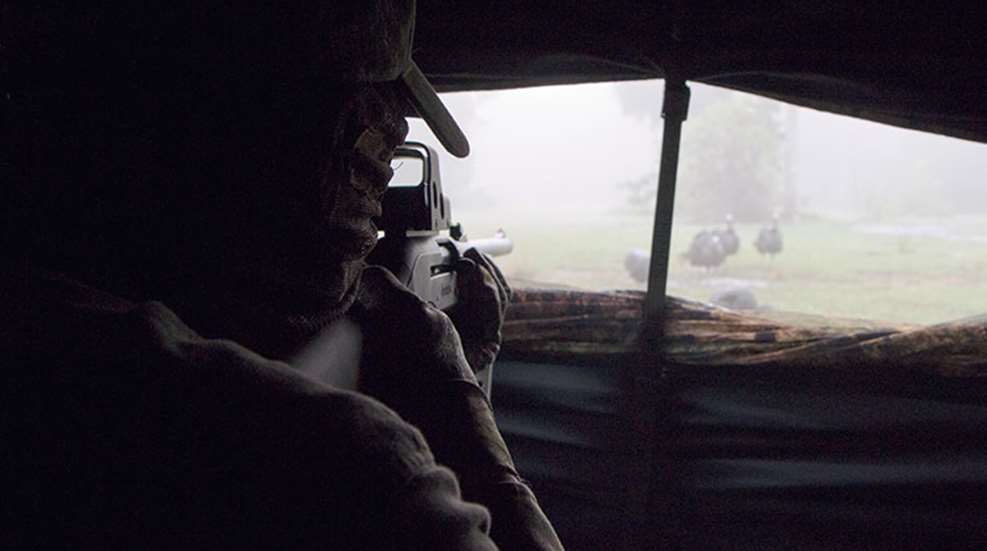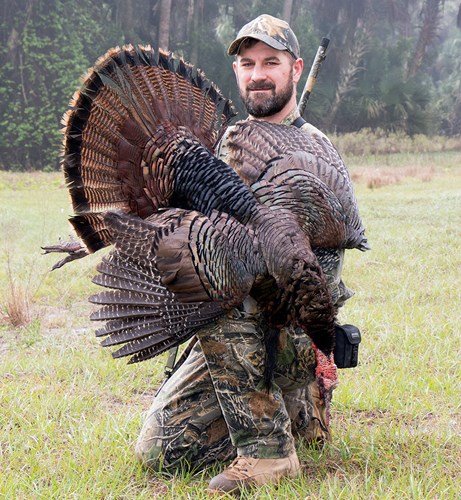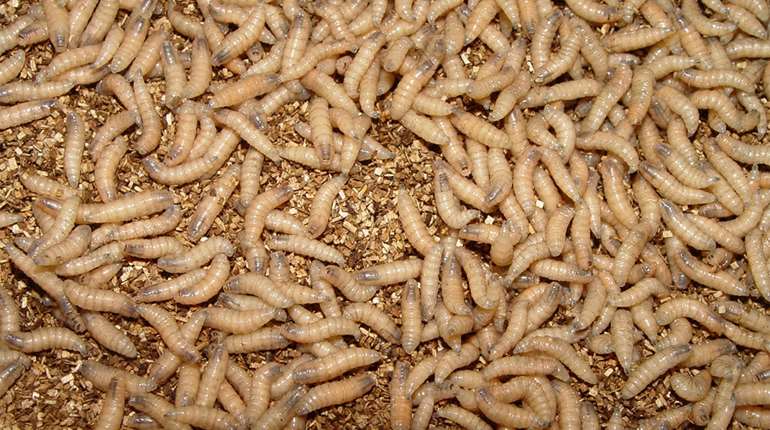
Next time I’m wearing shorts. The lightweight nylon-mesh kind that feel cool against sweaty skin. It’s not like the turkeys would see my pasty legs behind a blind. I’d just slather ’em in DEET and enjoy the steamy weather of southern Florida in early March like a good tourist should. For me, flying out of a snowstorm to hunt in the sunshine when turkey season at home was still more than a month away contributed greatly to the allure of the Osceola subspecies. Hunting birds in shorts could only make it better.
I was wondering what my blind-mates Anthony Brown and Jimmy Hook of Osceola Outdoors would think of this strategy when the first hen appeared. The humid air was thick with fog, and the three of us leaned forward in our chairs for a better look—as though cutting the distance from our eyes to the bird by a foot would help.
Three people in a blind, even a spacious Double Bull, was tight. If it were meant for three guys, Primos would call it a Triple Bull. As we invaded each other’s personal space with knees and elbows, I realized shorts may not be such a good idea.
Brushing your guide’s leg with yours when you’re both wearing long pants is hardly noticeable. Skin-to-skin contact, on the other hand, has the potential to create one of those awkward moments neither of you will soon forget.
The hen was little more than a fuzzy blob at the far end of a field bordered by palm trees. She was soon joined by more fuzzy blobs, all actively engaged in scratching and pecking and fluffing their feathers against the heavy morning air. The three of us watched and whispered, knowing there had to be birds with beards somewhere nearby. Jimmy saw three gobblers in this field the day before and, with his client already tagged out, volunteered to take us to “his” farm. He warned us the birds could be tightlipped, and so far he was right: We hadn’t heard any gobbles from the roost, and if the hens in the field were talking, they were keeping it between themselves.
Anthony kept his striker off the glass and matched the birds’ silence. Seduction and provocation would come from outside the blind. Earlier, while it was still dark, Jimmy lugged three Dave Smith decoys to the blind and staged a ménage à trios 15 yards in front of the shooting window. Two willing hens and one even more willing jake in strut—the lucky fake skewered atop some kind of motorized rig that made it rotate between options like a frat boy at happy hour. With a setup like that and a hunch that a group of swingin’ beards would eventually pass within sight, why call?
Twenty minutes later, when three taller birds swaggered from a row of palms in the distance and joined the hens, Anthony figured a little talk couldn’t hurt. This was the group of gobblers we were waiting for, and even through the fog I could tell they were all good birds. A few short but ringing yelps from Anthony’s pot call brought their heads up, and their necks stretched at attention.
But they were torn. They seemed satisfied to tend the flock of hens they were standing among. Still, they were curious about what was going on at the other end of the field, each occasionally thrusting its head in our direction as the minutes dragged by in the sticky air. Anthony worked his striker a bit more, and one of the longbeards took a few steps toward us. When the bird stopped to survey the situation, my guide pressed a button on the wireless remote in his hand, and our boy with the two plastic dolls began to spin in a slow circle.
That did it.
The gobbler went from hanging back to coming at a trot. His two buddies, suddenly realizing they were about to be late to the party, sent the hens scattering in their rush to catch up. The three of them covered the 100 yards to the decoys in seconds, heads low and beards swishing over the top of the wet grass.
They reached the rotating jake at the same time and wing-butt to wing-butt formed a line befitting a Revolutionary War skirmish. No doubt about it, they came to fight. They shuffled around the decoy purring with rage until the bird with the biggest bully complex decided he’d had enough. He broke formation with a quick hop, landing atop the fake with thrashing wings and gouging beak. When he was finished, the next bird delivered his beat-down. Then the third took a turn. Only after the decoy was missing its fan and the motorized stake was bent 90 degrees did the gobblers relent.
With the competition pounded into the sandy soil, the birds turned their attention to the hen decoys and separated enough to afford a clear shot. My cheek was on the 12-gauge, but Anthony and I couldn’t agree on which gobbler should get it. Anthony is a spur man. He has one hanging from his neck that pierces the tape at a full 2 inches. He wanted me to kill the bird with the longest spurs, which at less than 20 yards away were clearly visible. But that gobbler was missing half his beard, and I covet birds with lengthy ropes. After some hushed but heated back-and-forth, my guide finally told me to just shut up and shoot.
The Remington roared, but the action was far from over. The death flops of the bird with the longest beard drew the ire of the pair still standing, and together they waged war on their fallen “frenemy.” So violent and prolonged was their attack that I started to wonder how my poor gobbler would look in photos. The scene was just too good to interrupt, though, and I remained still while my facemask became plastered to my cheeks in sweat.
Thirty minutes later the birds walked off, hailing the carnage with simultaneous gobbles. The three of us stumbled from the blind, enjoying the hint of a breeze now that we were free from the confines of what was starting to feel like a sauna. Next time I’m wearing shorts, and for good measure they’ll have some kind of MMA logo on them. The turkeys around Lake Okeechobee love a good brawl.





































